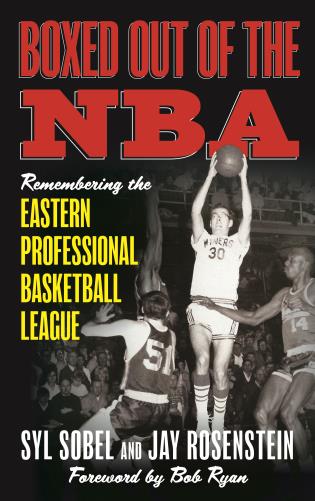
One of the best things about growing up in Scranton, Pa., in the 1950s and 1960s was following the local pro basketball team, the Scranton Miners. In my post last week, I interviewed coauthors Syl Sobel and my brother Jay Rosenstein about their terrific new book, Boxed Out of the NBA: Remembering the Eastern Professional Basketball League.
In this post I’ll add personal reflections about what the team (and the league) meant to me, as well as my continued thoughts about Syl and Jay’s book. Like Jay, I was a devoted follower of the team. And I mean that literally: not only did I go to all of the home games (at the CYC/Catholic Youth Center), but also to many “away games,” on bus trips the team arranged. The young owner of the team at the time, Arthur Pachter (who is prominently featured in Boxed out of the NBA), is a lifelong family friend.
Through the good graces of Arthur and his late brother Howard, I became assistant statistician to the team in my final season living in Scranton, 1968-1969, before moving to Washington to go to American University. My photo was in the team’s program, and I was the last-minute replacement as the public address announcer once during that final season. The book’s preface includes an anecdote, also related in their recent Book Q&A with Deborah Kalb, about how I threatened to boycott my own Bar Mitzvah party at the Scranton Jewish Community Center, because it conflicted with a Miners-Camden Bullets game one block away at the CYC. As Syl and Jay write, “Solomonically, however, Jay’s parents avoided a potential boycott by the guest of honor and agreed to let both sons, and their friends at the party, listen to the game on a pocket transistor radio.”
I also religiously studied, along with the statistics and features in the game programs, the articles about the team and its games in the Scranton Tribune (then the morning newspaper), and the Scranton Times, in the evening. (The papers have long since merged and are now The Times-Tribune.) I particularly enjoyed articles about the many trades Arthur Pachter engineered over the years, as I expressed an early, and now lifelong, affinity for learning about organizational personnel, and behind-the-scenes business maneuvers.
It is important to set the team and the league in its historical context. The league’s years were 1946-1978. My best guess is that I first saw a game around 1959 or 1960, meaning I had around a decade of going to games on weekends between November and March. The caliber of play in the league was dynamic and thrilling to watch, especially in small gyms where even marginal seats were relatively close to the action.
The NBA was undoubtedly popular during this era, but nothing like it is now, and it was certainly not the big business and pop culture phenomenon it has become. As the book points out in detail, the racial dynamics of the league (and of the entire country) were far different in those days, meaning that some of the best African American players in the United States, many of whom lived and worked in New York or Philadelphia, were stars in the Eastern League. If the NBA had as many teams then as it does now, many Eastern League players would probably have thrived there.
As I noted in the previous post, I was struck by how many Eastern League players went on to become high school, college, and pro coaches; as well as teachers and school administrators. The authors extensively interviewed such players-turned-famous coaches as Syracuse University’s Jim Boeheim (who played for the Miners and is on the book’s cover), and Temple University’s John Chaney, who passed away in January, at 89.
Chaney’s death brings out another factor of why the story of the book has been told not a minute too soon. This is a generation of people now in their 60s, 70s, 80s, and 90s. Many died years ago, and some, like Chaney, quite recently, after the book went to press. For instance, another player quoted by Syl and Jay, who like Boeheim went from Syracuse University to the Miners, Rich Cornwall, passed away February 2 at 74. A day earlier, Valentine “Val” Reid, a Syracuse teammate of Boeheim and Cornwall’s who also played for the Miners, passed away at 77.
Three players mentioned in the book also died recently. Jay “Pappy” Norman (a Temple University legend who played for the mighty Allentown Jets), at 87 in January; Harthorne Wingo (who went from the Jets to the New York Knicks in the early ‘70s), also in January, at 73; and Jim Huggard, a 1961 Villanova grad (as you can see, Philadelphia-area colleges were a steady source of players for the league), who played for the Miners and several other teams, last October.
To get more of the flavor of the intense local interest for both the Scranton Miners, and the Eastern League itself, watch the recording of the recent virtual book launch event, sponsored by the Library Express Bookstore of the Lackawanna County Library System, in Scranton. (I spoke there in person for my book Create Your Future the Peter Drucker Way, in 2014.)
Boxed Out of the NBA is an important book beyond the world of basketball. It weaves together strands of sociology, racial justice, the deeper meaning of athletics, teaching, coaching, and the tremendous work ethic so many of these players and coaches exhibited under less-than-ideal conditions. I recently read two quite interesting articles, one in the Washington Post, and another in The New York Times, about a course that professor David A. Hollander began teaching in 2019 at New York University, “How Basketball Can Save the World.” Boxed Out of the NBA would be a worthy addition to that course’s syllabus.
